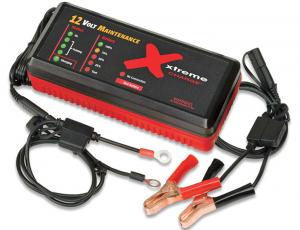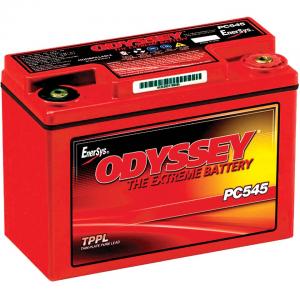 It’s hard enough to keep the battery in your ATV, truck, or Side x Side fully charged in the summer much less in the deep cold of winter. Batteries sure aren’t what they used to be! With a little preventative maintenance though you can keep your engine cranking. We’ll show you how.
It’s hard enough to keep the battery in your ATV, truck, or Side x Side fully charged in the summer much less in the deep cold of winter. Batteries sure aren’t what they used to be! With a little preventative maintenance though you can keep your engine cranking. We’ll show you how.
POWER LOSS
We’ve all heard the dreaded “click, click, click” of a dead battery and it’s never a happy moment. Most of the time you don’t notice the signs of impending battery failure, but little by little, the degradation of your batteries ability to hold a charge marches relentlessly towards that fateful day, seemingly like a visit from the Grim Reaper of power cells. 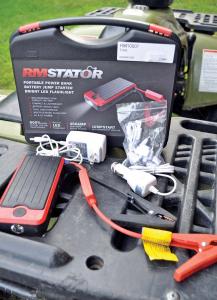
“When it’s cold outside, sulfation buildup on battery plates in combination with the slowdown of the chemical reaction within the battery will rob the battery’s ability to provide power when you need it most. This is made worse as vehicle fluids thicken due to the cold,” said PulseTech Products company spokesman Rick Miller. “The cold condition of the engine and fluids requires even more cranking power from the battery so the battery has to work harder than normal to provide additional starting power. The result is a further reduction in voltage which causes faster buildup of sulfates on the lead plates.” It’s an ugly cycle that spins deeper towards the point of no return.
Miller went on to point out that the battery’s electrolyte fluid can actually freeze if the battery is in an advanced state of discharge, and this will likely damage the lead plates resulting in having to replace the battery. Electrolyte fluid in a completely discharged battery will freeze at only 8°F. When that happens you are almost certainly about to begin battery shopping, and there are several types to choose from.
BATTERY TYPES
The workhorse lead-acid battery handles the lion’s share of stored electrical power requirements in most of today’s vehicles. This includes standard flooded, gel, and the newer, sealed AGM (Absorbed Glass Mat) battery types. As good as these batteries are they all suffer from the same main failure mode—80% of all lead-acid batteries fail due to the damaging effects of sulfation build up. If left unmanaged, sulfates found in the electrolyte will crystallize and root onto the battery plates and eventually result in premature battery failure. This is especially true with seasonally used vehicles like motorcycles, water craft, mowers, etc. Thanks to their ability to be used year round ATVs and Side x Sides are less prone to this, but it still happens. Vehicles that retain a small load on the battery even when the engine isn’t running (called key off parasitic loads) have the same problems.
Sometimes gel and AGM batteries are called VRLA batteries. This means VALVE REGULATED, and they are fully sealed which has several advantages over your standard battery such as:
-
The battery can be mounted in almost any position (conventional batteries must remain upright)
-
They are fully sealed and won’t leak fluids or fumes
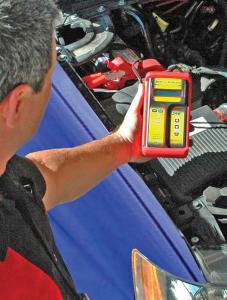
Vibration resistant
-
Maintenance-free
While VRLA Gel and AGM batteries are similar and work on the same principal of the chemical exchange within the battery is absorbed and contained making them maintenance free, they do have differences as well. The differences are:
-
Gel batteries contain a gelled electrolyte consisting of sulfuric acid, fumed silica, pure water that has been demineralized and deionized, and a phosphoric acid.
-
Gel battery electrolyte has the consistency of light grease or petroleum jelly
-
Gel batteries tend to lose charge quicker in temperatures below 32°F and a shorter overall life span
-
Gel batteries generally have a higher price
-
AGM batteries electrolyte contains highly refined sulfuric acid and pure, demineralized, deionized water.
-
AGM battery electrolyte is trapped in sponge-like glass mat separators
-
AGM batteries perform well in high power applications and when running accessories such as a winch or extra lights
-
AGM batteries show less power loss in extreme cold
-
AGM battery life is often superior to Gel and offer excellent durability in power sports applications. They are a good value for the price
MAINTAIN POWER
Regardless of the type of battery you choose, a regular maintenance formula can keep your machine ready to go when you need it. The simple formula is: Test, Charge, Recover and Maintain. 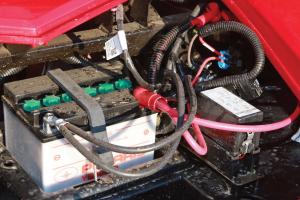
TESTING - In testing a battery’s voltage, there are three important levels to consider. First test the no load voltage level with the engine off. The reading should be around 12V. The second voltage level is cranking voltage, which will drop below 12 V as the engine starts. The third reading is the charging level, which tests alternator function to assure the battery is getting charged when the engine is running. This test usually registers around 13.8V to 14V. If in any of these three tests, numbers are substantially below normal ranges you are facing either battery or alternator problems.
CHARGE AHEAD - If your test reveals low voltage on a battery that has been sitting for a substantial time you can try fully charging it before you start the vehicle, or starting the engine with a secondary power source such as a booster pack, or by jumping it from another vehicle. When you get it started then go for a ride or otherwise run the engine long enough for the alternator to fully recharge the battery. That’s the easy way. If the battery does not take a charge you’re back to the dreaded battery or alternator problems.
RECOVERY - If the battery does not recharge you may have a case of the sulfation gremlins described above. Before you order up a new battery try a recovery charger. A powerful recovery charger will restore the ability of the battery’s plates to accept and release energy. It does this through a strictly controlled waveform, comprised of rise time, pulse-width, frequency and amplitude of current and voltage pulse that attack the existing sulfation areas. Think of it as scrubbing away the crud and you’ll get the idea. Used as part of a routine maintenance program, smart charges have delivered impressive results, improving battery performance and extending life cycles. PulseTech’s patented Pulse Technology system can make this possible. They’ve even been able to recover a discharged battery that will no longer accept a charge, at least if the battery has not been damaged by a short circuit or in some other way.
MAINTAIN - When your machine isn’t going to be used for a long while it’s a good idea to connect a maintenance charger. A 12-Volt battery maintenance system will keep sulfation at bay while maintaining a full charge at all times. These can be a simple tool or some have full diagnostic and maintenance capabilities. Regardless of how complicated a tool you acquire you are assured your ATV, Side x Side, truck, or tractor is ready to go when you are, and that makes it worth the price.
READY TO ROLL
By keeping your batteries plates clean and fully charged the battery is ready to work harder than ever. It maintains a greater reserve capacity, will recharge faster and release more of its stored energy when you crank the key. That’s exactly what we all want.


